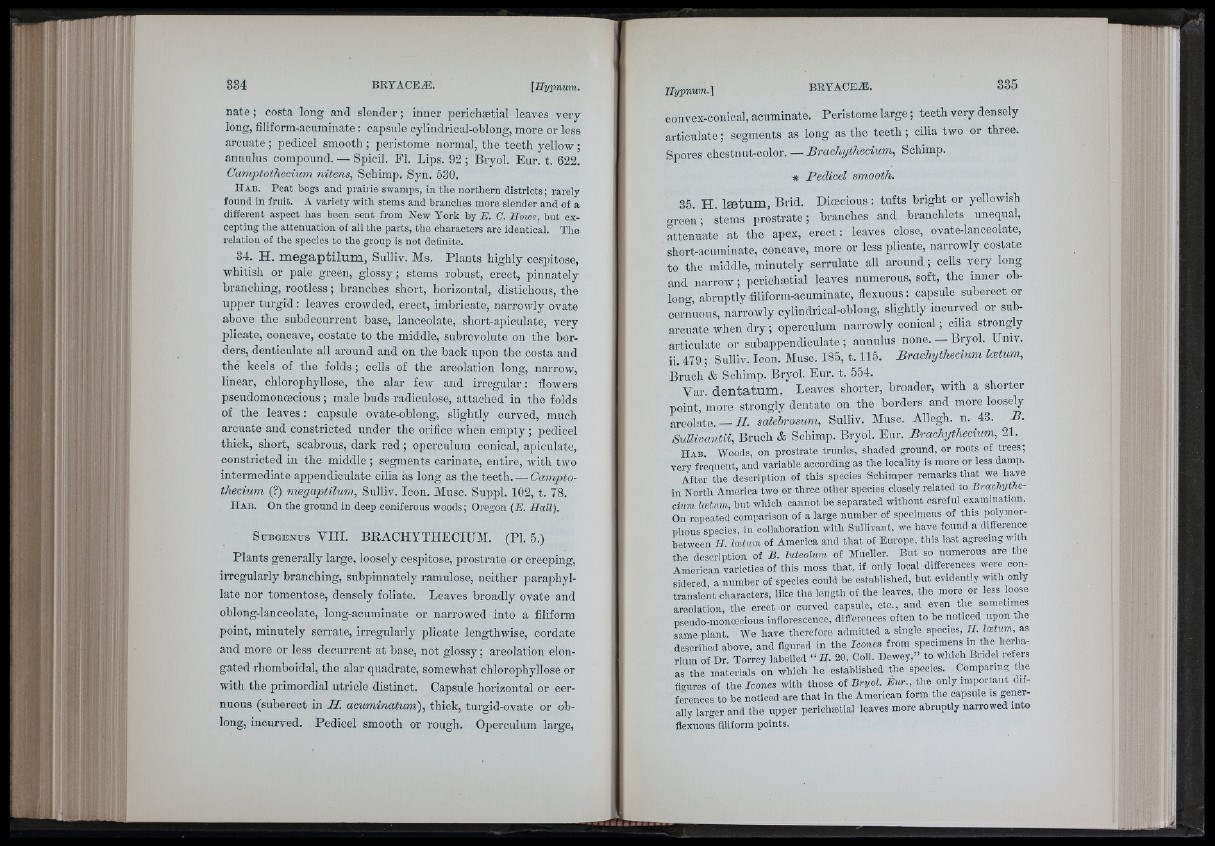
I',
• : ! i “
! i I i i:
î ;
nate ; costa long and slender ; inner perichætial leaves very
long, filiform-acuminate : capsule cylindrical-ohlong, more or less
arcuate ; pedicel smooth ; peristome normal, the teeth yellow ;
annulus compound. — Spicil. FI. Lips. 92 ; Bryol. Eur. t. 622.
Camptothecium nitens, Schimp. Syn. 530.
IIa b . Peat bogs and praiiie swamps, iu tlie northern districts; rarely-
found in fruit. A variety with stems and branches more slender and of a
different aspect has been sent from New York by E. C. Howe, but excepting
tlie attenuation of all the parts, tlie characters are identical. The
relation of tlie species to tlie group is not definite.
84. H. m eg ap tilum , Sulliv. Ms. Plants highly cespitose,
whitish or pale green, glossy; stems robust, erect, pinnately
branching, rootless ; branches short, horizontal, distichous, the
upper turgid : leaves crowded, erect, imbricate, narrowly ovate
above the subdecurreut base, lanceolate, short-apiculate, very
plicate, concave, costate to the middle, suhrevolute on the borders,
denticulate all around and on the back upon the costa and
the keels of tbe folds; cells of the areolation long, narrow,
linear, chlorophyllose, the alar few and irregular: flowers
pseudomonoecious ; male buds radiculose, attached in the folds
of the leaves : capsule ovate-oblong, slightly curved, much
arcuate and constricted under the orifice when empty ; pedicel
thick, short, scabrous, dark red ; operculum conical, apiculate,
constricted in the middle ; segments carinate, entire, with two
intermediate appendiculate cilia as long as the teeth. — Camptothecium
(?) megaptilum, Sulliv. Icon. Muso. Suppl. 102, t. 78.
H a b . On tbe ground in deep coniferous woods; Oregon (E. Hall).
SuBGBNus VIII. BRACHYTHECIUM. (PI. 5.)
Plants generally large, loosely cespitose, prostrate or creeping,
irregularly branching, suhpinnately ramulose, neither parapliyl-
late nor tomentose, densely foliate. Leaves broadly ovate and
ohlong-lanceolate, long-acuminate or narrowed into a filiform
point, minutely serrate, irregularly plicate lengthwise, cordate
and more or less decurrent at base, not glossy ; areolation elongated
rhomhoidal, the alar quadrate, somewhat chlorophyllose or
with the primordial utricle distinct. Capsule horizontal or cernuous
(suberect in II. acuminatum), thick, turgid-ovate or ohlong,
incurved. Pedicel smooth or rough. Operculum large.
convex-conical, acuminate. Peristome large ; teeth very densely
articulate ; segments as long as the teeth ; cilia two or three.
Spores diGstnvit-coloY.— Brachythecium, Schimp.
* Pedicel smooth.
35. H. læ tum , Brid. Dioecious : tnfts bright or yellowish
oreen; stems prostrate; branches and branchlets unequal,
attenuate at the apex, erect; leaves close, ovate-lanoeolate,
short-acuminate, concave, more or less plicate, narrowly oostate
to the middle, minutely serrulate all around ; cells very long
and narrow ; perichætial leaves numerous, soft, the inner ob-
lono- abruptly filiform-acuminate, flexnous; capsule suberector
cernuous, narrowly cylindrical-oblong, slightly incurved or sub-
arcnate when dry ; operculum narrowly conical ; cilia strongly
articulate or subappeiidiculate ; annulus none. — Bryol. Univ.
ii. 479 ; Sulliv. Icon. Muso. 185,1.115. Brachythecium lætum,
Bruch & Schimp. Bryol. Eur. t. 554.
Var. d e n ta tum . Leaves shorter, broader, with a shorter
point, more strongly dentate on the borders and more loosely
areolate. — /7. salebrosum, Sulliv. Muse. Allegh. n. 43. B.
Sullivantii, Bruch Æ Schimp. Bryol. Eur. Brachythecium, 21. ^
H a b . Woods, on prostrate trunks, shaded ground, or roots of trees;
very frequent, and variable according as the locality is more or less damp.
After the description of this species Schimper remarks that we have
in North America two or three other speeies closely related to Braehythe-
cium lætum, but which cannot be separated without careful examination.
On repeated comparison of a large number of specimens of this polymorphous
species, in collaboration with Sullivant, we have found a difference
between H. lætum of America and that of Europe, this last agreeing with
the description of B. luteolum of Mueller. But so numerous are the
American varieties of this moss that, if oniy iocal differences were considered
a number of species could be established, but evidently with only
transient characters, like the length of the leaves, the more or less loose
areolation, the erect or curved capsule, etc., and even the sometimes
pseudo-monoecious inflorescence, differences often to be noticed upon the
same plant. We have therefore admitted a single species, H. lætum, as
described above, and figured in the leones from specimens in the herbarium
of Dr. Torrey labelled “ H. 20, Coll. Dewey,” to which Bridel refers
as the materials on which he established the species. Comparing the
fi:.ures of the leones with those of Bryol. Eur., the only iinpormnt differences
to he noticed are that in the American form tlie capsule is generally
larger and the upper perichætial leaves more abruptly narrowed into
flexuous filiform points.